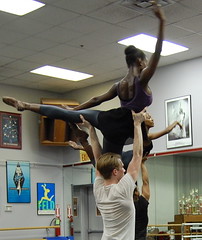Dance terms in ballet and modern are mostly derived from French, owing to the influence of Louis XIV.
Arabesque [a-ra-BESK] One of the basic poses in ballet, arabesque takes its name from a form of Moorish ornament. In ballet it is a position of the body, in profile, supported on one leg, which can be straight or demi-plié, with the other leg extended behind and at right angles to it, and the arms held in various harmonious positions creating the longest possible line from the fingertips to the toes.
Derrière [deh-RYEHR] Behind, back. This term may refer to a movement, step or placing of a limb in back of the body. In reference to a particular step, the addition of derrière implies that the working foot is closed at the back.
Jeté, grand [grahn zhuh-TAV] Large jeté. In this step the legs are thrown to 90 degrees with a corresponding high jump. It is done forward to attitude croisée or effacée, and to all the arabesques. It may also be done backward with the leg raised either croisé or effacé devant. Grand jeté is always preceded by a preliminary movement such as a glissade.
Pirouette [peer-WET] Whirl or spin. A complete turn of the body on one foot, on point or demi-pointe.
Plié [plee-AY] Bent, bending. A bending of the knee or knees.
Sauté, sautée [soh-TAY] Jumped, jumping.
Monday, November 29, 2010
Subscribe to:
Post Comments (Atom)





No comments:
Post a Comment